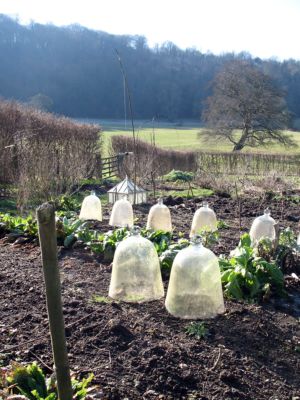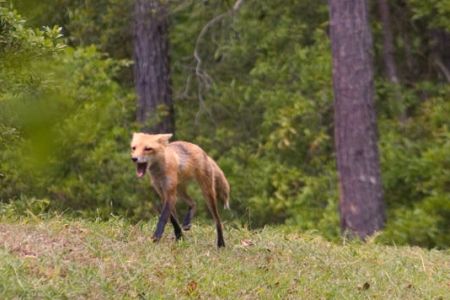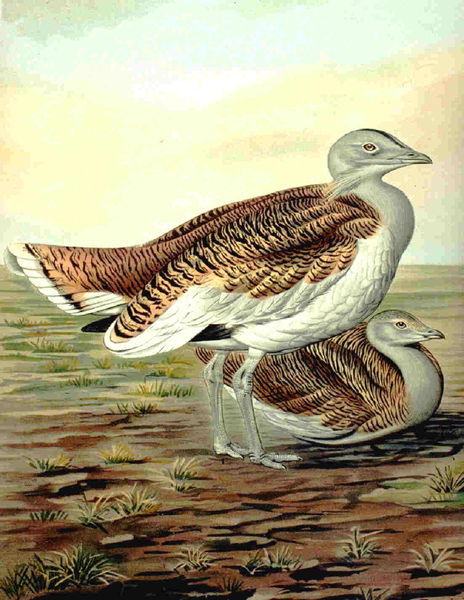Posted by sydney on Feb 29th, 2008
Posted by sydney on Feb 17th, 2008

Glasses and early spinach at the reproduction of Gilbert White’s kitchen garden. Selborne, Hampshire, February 17, 2008.
- 1793: February 17, 1793 – Sent some winter-aconites in bloom to Dr. Chandler; & received back some roots of Arum dracunculus. Tubbed, & salted-up a fine young hog, bought of Timothy Turner.
- 1788: February 17, 1788 – Mr Ch: Etty sailed for Bombay, & Canton aboard the Montrose India man in the capacity of third mate. Later note: He was delayed, & did not sail till the last week in March.
- 1787: February 17, 1787 – Cucumber-plants thrive, & are pinched to make them throw-out side shoots.
- 1783: February 17, 1783 – Partridges are paired. Foot-paths in many places very clean.
- 1782: February 17, 1782 – Last night the moon was midway between Mars & Venus: she is this evening just above, close above the former, at the seeming distance of two feet.
- 1780: February 17, 1780 – Sowed a crop of spinage, the autumn-sown being much diminished by the frost. Ground works well. Planted broad-beans.
- 1779: February 17, 1779 – Bees rob each other, & fight.
- 1774: February 17, 1774 – Ravens begin to build. Spring-like weather.
- 1770: February 17, 1770 – Storm, rain, sleet.
- 1769: February 17, 1769 – Pease are sown in the fields. Land-springs abate.
Posted by sydney on Feb 16th, 2008
- 1785: February 16, 1785 – Men sow peat-ashes on their Grasses. Winter-aconites make a gay show.
- 1781: February 16, 1781 – No hares frequent the garden.
- 1779: February 16, 1779 – Crocus’s blow-out. When the vernal crocus blows, the autumnal crocus peeps out of the ground. Bees gather on the crocus.
- 1774: February 16, 1774 – Skylarks mount, & essay to sing. House-sparrows get in clusters, & chirp, & fight. Thrushes whistle.
- 1769: February 16, 1769 – Daws to the churches.
Posted by sydney on Feb 15th, 2008
- 1793: February 15, 1793 – Rain & hail in the night. Made a seedling-cucumber bed: mended the frame, & put it on.
- 1792: February 15, 1792 – Crown imperials sprout.
- 1788: February 15, 1788 – Taw & hop-scotch come in fashion among the boys.
- 1784: February 15, 1784 – Snow deep, & drifted thro’ the hedges in curious, & romantic shapes.
- 1783: February 15, 1783 – Drank tea at Newton by day-light. Sheep on the down look deplorably!
- 1781: February 15, 1781 – Strong N. aurora: very red in the N.E.
- 1779: February 15, 1779 – A vivid Aurora: a red belt from East to West.
- 1778: February 15, 1778 – The sun at tsetting shines into the E. corner of my great parlor.
- 1773: February 15, 1773 – Helleborus viridis emerges & blows.
- 1768: February 15, 1768 – Cucumber plants show two rough leaves. Forward turneps rot. Evergreens appear more damaged than at first was imagined, especially those in sunny aspects. Bees gather on ye winter aconite. Arbutus but little damaged by the frost. Ilex much hurt. Hollies, pinched by the frost, cast their leaves. Laurustinus killed to the ground.
Posted by sydney on Feb 14th, 2008

Vocalizing fox, photo by Trevor P. Hirst
- 1791: February 14, 1791 – Potted cucumbers: bed warm.
- 1786: February 14, 1786 – Bullfinches eat the buds of honey-suckles.
- 1784: February 14, 1784 – Sent Thomas as Pioneer to open the road to Faringdon: but there was little obstruction, except at the gate into Faringodn Hirn.
- 1783: February 14, 1783 – Showers. A perfect & lovely rain-bow.
- 1781: February 14, 1781 – A pair of ravens build in the hanger.
- 1778: February 14, 1778 – Foxes begin now to be very rank, & to smell so high that as one rides along of a morning it is easy to distinguish where they have been the night before. At this season the intercourse between the sexes commences; & the females intimate their wants to the males by three or four little sharp yelpings or barkings frequently repeated. This anecdote I learned by living formerly at an house opposite to a neighbour that kept a tame bitch-fox, which every spring about candlemass began her amorous serenade as soon as it grew dark, & continued it nightly thro’ ye months of Feb. & March.
- 1774: February 14, 1774 – The ivy, hedra helix, blows in Sept: Octr & Novr: the berries are now full-grown, & ripen in April: thus fructification goes on in some Instances the winter thro’. When the berries are full ripe they are black.
Posted by sydney on Feb 13th, 2008

Great Bustard
- 1792: February 13, 1792 – Sowed the ashes of my own making in the great mead, where the grass is finest. Finished tacking the fruit wall-trees. Gossamer streams from the boughs of trees. Brimstone butterfly, Papilio rhamni.
- 1791: February 13, 1791 – As there has been little frost, the antirrhinum cymb: flourishes, & blossoms thro’ the winter.
- 1789: February 13, 1789 – Lined the hot-bed screen with reeds. Cucumbers come-up well: bed works well.
- 1784: February 13, 1784 – This evening the frost has lasted 28 days.
- 1782: February 13, 1782 – Things froze in the pantry. Shallow snow: ground very hard.
- 1781: February 13, 1781 – Stormy all night. Much thatch blown-off, & some trees thrown down.
- 1780: February 13, 1780 – Turnips are all rotten.
- 1774: February 13, 1774 – Hedge-sparrow sings. Great flock of buntings in the fields towards Faringdon.
- 1772: February 13, 1772 – Wood-pecker laughs. Spring-like weather. Skylark mounts & sings. Crocus begins to blow.
- 1770: February 13, 1770 – Saw bustards on Salisbury plain: they resemble fallow-deer at a distance. Partridges pair. Wild-geese in the winter do damage to the green wheat on Salisbury plain.
The Great Bustard became extinct in Britain in the 1840s; hardly surprising given the inevitable fate of unusual and notable birds mentioned in these journals (shot, shot, shot, and shot. Changing farming practices also bear some responsibilty). They are currently being reintroduced with some success by the Great Bustard Group.
Posted by sydney on Feb 12th, 2008
- 1793: February 12, 1793 – Mrs. J. White returns.
- 1789: February 12, 1789 – About this time Miss Chase, & Miss Rebecca Chase sailed for Madras in the Nottingham India-man.
- 1781: February 12, 1781 – Sea-gulls appear: in stormy weather they leave the sea.
- 1780: February 12, 1780 – The farmers begin to plow after the frost.
- 1777: February 12, 1777 – About the beginning of July, a species of Fly (Musca) obtains, which proves very tormenting to horses, trying still to enter their nostrils, and ears, & actually laying their eggs in the latter & perhaps in both of those organs. When these abound, horses in wood-land districts become very impatient with their work, continually tossing their heads & rubbing their noses on each other, regardless of the driver: so that accidents often ensue. In the heat of the day, men are often obliged to deist from plowing: saddle-horses are also very troublesome in such season. Country-people call this insect the nose fly. In the decline of the year when the morning & evening become chilly, many species of flies (muscae) retire into houses, & swarm in the windows. At first they are very brisk & alert: but as they grow more torpid, one cannot help observing that that they move with difficulty, & are scarce able to lift their legs, which seem as if glued to the glass: and by degrees many do actually stick on till they die in the place. Now as flies have flat skinny palms, or soles to their feet, which enable them to walk on glass & other smooth bodies by means of the pressure of the atmosphere; may not this pressure the the means of their embarrassment as they grow more feeble; ’til at last their powers become quite inadequate to the weight of the incumbent air bearing hard upon their more languid feet; & so at last they stick to the walls & windows, where they remain, & are found dead.
- 1775: February 12, 1775 – Sad accounts from various parts of devastations by storms & inundations. A spoon-bill platalea leucorodia Linn: was shot near Yarmouth in Norfolk: it is pretty common in Holland, but very rare indeed in this island. There were several in a flock. They build Willughby says, like Herons in tall trees. Their feet are semipalmated. Those birds in Norfolk must have crossed the German ocean.
- 1770: February 12, 1770 – Yellow-hammer, emberiza flava, sings. Bee gathers on the snow-drops. Bunting sings.
- 1769: February 12, 1769 – Snow, fog, sleet. Icicles. Snow on the hills.
White will speculate again 14 years later on the flies-on-windows issue, but his vacuum theory is incorrect– insects use fine velcro-like hairs to stick to smooth surfaces.
Posted by sydney on Feb 11th, 2008
- 1793: February 11, 1793 – Paths get dry. Sowed a bed of radishes, & carrots under the fruit-wall.
- 1792: February 11, 1792 – The meadow measures 2 acres & 19 rods, besides the dug ground.
- 1790: February 11, 1790 – Three gallons of best french brandy from London.
- 1784: February 11, 1784 – Snow covers the ground. Hares again in the garden.
- 1780: February 11, 1780 – Eruptive fevers, & sore throats lurk about the parish: some die of this disorder.
- 1773: February 11, 1773 – Reduced my barometer to the true standard of 28 inches, lowering it about two degrees.
- 1772: February 11, 1772 – Large titmouse sings.. Chaffinch sings. Hot sunshine. Snowdrops blow.
- 1770: February 11, 1770 – Linnets whistle inwardly as they sit in flocks.
- 1768: February 11, 1768 – Went to Oxford from London.
Posted by sydney on Feb 10th, 2008
- 1791: February 10 – Brewed strong beer.
- 1790: February 10, 1790 – Bullfinches pick the buds of damson-trees.
- 1787: February 10, 1787 – Took Mrs. Etty’s ashes, 28 bushels; paid her.
- 1784: February 10, 1784 – No hares have frequented the garden since the man shot, & killed one, & wounded an other.
- 1783: February 10, 1783 – Sheep rot very much. Ewes & lambs are much distressed by the continual wet.
- 1781: February 10, 1781 – The nuthatch brings his nuts almost every day to the alcove, & fixing them in one corner of the pediment drills holes in their sides, & after he has picked out the kernels, throws the shells to the ground.
- 1775: February 10, 1775 – Mezereon in fine bloom. Peter Wells’s well runs over. Spiders, woodlice, lepismae in cupboards, & among sugar, some empedes, gnats, flies of several species, some phalenae in hedges, earth-worms, &c., are stirring at all times when winters are mild; & are of great service to those soft-billed birds that never leave us.
- 1774: February 10, 1774 – Weather shifts continually from frost to rain to the detriment of the wheat & turneps. Wheat looks sadly, & is almost heaved-out of the ground.
- 1773: February 10, 1773 – Severe frost. Bottles of water freeze in chambers. Snow in the night. Cutting air.
- 1772: February 10, 1772 – Made cucumber bed. Snow gone on the hills. Winter aconite blows.


